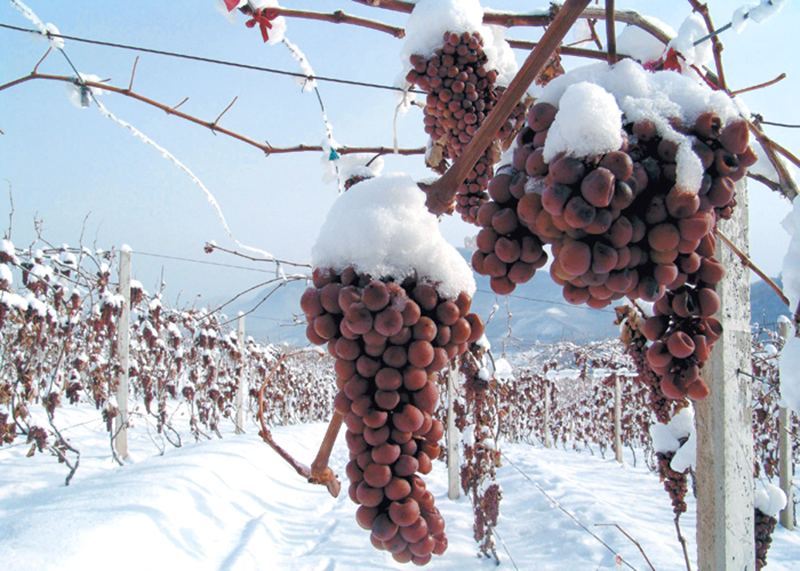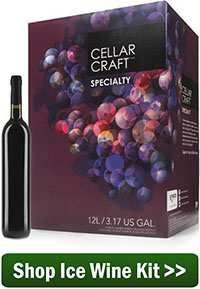 My friend came from Canada and would like me to make ice wine. Is there a particular grape to use. I make scuppernong wine quite well in NC. Do you have an ice wine recipe you could provide me with.
My friend came from Canada and would like me to make ice wine. Is there a particular grape to use. I make scuppernong wine quite well in NC. Do you have an ice wine recipe you could provide me with.
Sue – NC
—–
Hello Sue,
I’m not sure if I can answer your question directly. That’s because making ice wine is more of a process. It’s really not made using an ice wine recipe, per se.
Ice wine is traditionally made from grapes that have been kept on the vine on into the colder winter months. The grapes are crushed and presses while they are frozen. Since it is only the water in the grapes, not the sugar and flavors, that are frozen, what releases during pressing is a concentrated juice with plenty of sugar and flavor. A majority of the water in the grapes is left behind in the wine press along with the pulp and skins. The result is a wine with lots of flavor and aroma.
As you might expect, ice wines normally come from the cooler regions of the world: Germany, British Columbia, etc. where this freezing occurs early and readily, but in North Carolina you can simulate this to some degree by freezing grape in a freezer and then crushing and pressing them very quickly, before the water in them has time to thaw and incorporate back into the juice. For example, you could try doing this outside on one of your coldest days. Pull the grapes out of the freezer and work quickly. This is what is at the heart of this wine, not an ice wine recipe.
Ice wine is made from a variety of different wine grapes such as: Riesling, Chardonnay, Gewürztraminer, Chenin Blanc, even Cabernet Sauvignon, etc. All these grapes are wine varietals where 100% of the juice is used with no sugar or water added, regardless if it is made as an ice wine or not. That is one of there reasons there’s really not an ice wine recipe.
In the case of Scuppernong grapes where sugar and water is often added to cut the tartness of the grape, coming up with an ice wine recipe using them can be a little tricky.
If I were to approach a Scuppernong ice wine for the first time, I would freeze, crush and press as discussed before. Then I would add a sugar/water mixture to the wine must until I knew the acidity was diluted to a decent range. This can be done with an Acid Test Kit. Take an acid reading of your freshly pressed ice juice. The directions that come with the Acid Test Kit will give you the optimal acid level for your wine.
The water/sugar mixture should be made up of 2.5 pounds of sugar (5 cups) for every gallon of water. Hopefully, you do not need to add too much, since this is counterproductive to having the grapes frozen in the first place.
Once you have the wine must set up, the process is just as you have done in the past when you’ve made your grape wine. Add wine yeast, yeast nutrient and let the fermenting begin. No acid blend or wine tannin are need since plenty of both are coming from the ice-ed grape juice.
Realize that if you have some other grapes available to you besides Scupernong  – some grape varietals, the icing process would be a lot more effect since no water would need to be added back to cut the acidity of the juice. This is as close as I can get for you to an ice wine recipe.
– some grape varietals, the icing process would be a lot more effect since no water would need to be added back to cut the acidity of the juice. This is as close as I can get for you to an ice wine recipe.
You may also want to consider making wine from an ice wine ingredient kit. These kits have already had the freezing, crushing and pressing all taken care of for you. You do not need to worry about adjusting the acidity, or anything like that, either. Just follow the directions that comes with the ingredient kit, add the additional packets when called for, and you will have an ice wine with plenty of flavor and a big bouquet.
Happy Winemaking,
Ed Kraus
—–
Ed Kraus is a 3rd generation home brewer/winemaker and has been an owner of E. C. Kraus since 1999. He has been helping individuals make better wine and beer for over 25 years.

Ed – I just made a batch of Pinot Gregio (6 gallon bucket) with great results.I bottled 29 bottles which is normal for this size.I have noticed that there is a granular substance on the bottom of the bottle,white in nature.the wine is crystal clear and great in flavor. Can I avoid these crystals – Dave
yes that’s sugar add higher yeast and wait
I found out that Ice Wine was made from grapes that were left on the vine until after a freeze and assumed that like several other fruits & vegetables that they got a better taste after the first frost or 2. Wish I had learned a couple years ago that it was obtained by pressing FROZEN grapes. If so I would have frozen my grapes whole instead of pressing then freezing.
What other fruits would Ice Wine process benefit from? ATT I only have Blueberries and Elderberries in frozen storage. Would Blueberries pressed frozen gain a similar boost in flavor or is the water content in them too low to start with??
no, it wont harm only make better, wine need not be grape only can be any fruit!
The taste is in the consumer, I make wine from all fruits! your taste in fruits will be a delightful taste- Berries! Yum!
I have made Faux Ice wine with good results. I bought some commercial ice wine and measured the acid level and the brix. I took some Niagara wine I had and opened 4 bottles into a carboy. I adjusted the acid and brix to match the real ice wine. ItDon was preferred by many to the real ice wine and a whole lot cheaper!
Don
not the same as making your own I have added preboxed wine to fermenting , works well! Nothing is as good as homemade!
I have made Faux Ice wine with good results. I bought some commercial ice wine and measured the acid level and the brix. I took some Niagara wine I had and opened 4 bottles into a carboy. I adjusted the acid and brix to match the real ice wine. It was preferred by many to the real ice wine and a whole lot cheaper!
Don
Any thoughts on hard cider making? Specifically what yeasts do you recommend for pear cider and what yeasts do you recommend for some cider? Thank you for all if your great advice!
Kim, Many of the yeasts used in brewing beer or making wine will work for making hard cider at home, too. Wine and champagne yeast have a higher alcohol tolerance and tend to finish dry. For a sweeter, fruitier cider, use an ale yeast, such as Nottingham. Wyeast 4766: Cider and Red Star Premier Blanc are both suitable for higher gravity ciders.
Do you have any recipes for cake sours? Thank you
Kim, I am sorry but we do not have a recipe for cake sours.
My recipe for Ice Wine
Yeast can ferment at the temp. of 32 degrees or above or below,( Hence Ice-which is the freezing point of water) or as low as 27F! since it is called iced alcohol, I run it through a chill process (freezing) after which I crush the fruit into a pulp add sugar or not ( I like to add Bread preferable bread with nuts as it adds a Nut flavor taste to the wine),
After 45 yrs of making wine, what I do is ferment right away (after prep, crushing fruit, add or not sugar, Yeast), freeze brew at 27 to 30F for 10 days then go to at about 45 to 60F AFTER about 10 days!!, depending on the product and yeast! (Right now I am fermenting fresh Key Limes, Lemonade with cranberries and Raspberries I call it Winter Delight! It currently is 45 degrees! Smells like fresh Limeaide Yum! outside) I use fresh fruit, frozen, as all the antioxidants are in the skin! I wash the Fruits with bleach (to kill micro germs that live in the pores of fruit skins- Not fragile fruits! Strawberries, Grapes ect.) such as Hard skin fruits- Lemons, Grapefruits, Oranges etc. after I wash with clean soapy water then rinse with hot water I cut and throw skins fruit and all in, Skin and all!!, after about 10 days, I squeeze the fruits dry and throw away the skins and bread (Filter with Cheesecloth)- skins will make a bitter taste after 10 days- ferment until you are happy with taste and clarity then begin step 2 (process 2) WAIT! It only takes 10 days to make ferment alcohol- but time makes good taste the longer the dryer! Don’t want Dry
I put in jugs and put in 140F for 1 min. and the yeast is dead, strain bottle, chill and enjoy!!